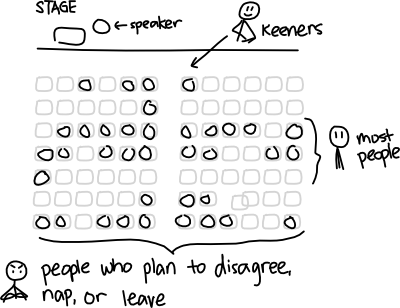How I learned to stop worrying and love the webinar – Part 1: The best seats in the house
Posted: - Modified: | speakingI was talking to one of my mentors about the recent presentation I’d given on Remote Presentations That Rock. I told him that I actually prefer giving webinars over giving face-to-face presentations because I can connect with people better that way. This surprised him, because most speakers still treat webinars as a poor alternative to face-to-face presentations. So that prodded me to figure out why webinars work really well for me. I suspect there’s a good series of blog posts and maybe a presentation in here about virtual presentations and real intimacy, so let’s explore!
How I learned to stop worrying and love the webinar
Part 1. The best seats in the house
Here’s where people typically sit in an in-person presentation:
This is a tough room to speak to.
- The people at the back are going to be very difficult to engage. They’re far. They might find it hard to hear you. They know they’re anonymous in the darkness. They’re surrounded by people who have probably already tuned out, so even if you do say something interesting once in a while, social proof influences them to disengage and to stay disengaged.
- The people in the middle may drift in and out. They think that the talk probably won’t be that interesting, because few people are enthusiastic enough to sit in front and a number of people have already mentally checked out in the back.
- The people in front will tempt you to focus on them. They’re the ones taking notes and silently cheering you on. It’s easy to focus on them without realizing it, but if you stop trying to draw the middle crowd and the back crowd in through eye contact and energy, you’re going to lose those audiences for sure.
- Empty seats reduce the energy in the room and make your talk seem less popular. After all, if it were really valuable, the room would be packed, wouldn’t it? (Never mind that this was the only size of room you could book.) The empty space makes it difficult for people to be enthusiastic. There’s no buzz.
Gross overgeneralizations, of course. Steve Jobs probably never has to deal with this, but if you’re not a celebrity presenter, you might’ve seen something like in real life.
How do you deal with it?
Approach #1. Ask people to stand up and move to the front. You’ll get a few people to move, but most will shrug it off with “No, thanks” or “I’m fine where I am.” You can’t spend too much time on this either, because it gets really awkward, and you run the risk of making your audience hostile.
Approach #2. Remove seats or book a smaller room than you need. If you pack the front rows with people, the character of the room can change significantly. If you removed seats, you can always add seats as more people come in. This requires more effort and coordination, and the organizer really needs to take charge of this because you’re going to be doing a lot of prep work as a speaker already. Alternatively, book a smaller room if possible. Downside: you limit the number of people who can attend your talk.
Even in packed presentations (such as technical talks for hundreds of people in the audience), these challenges are still there to some degree. A stage separates you from people. Without a stage, however, it’s hard for a large audience to see you. The larger the audience is, the more challenging it becomes to connect. You need to use a microphone (wireless lapel mic, if at all possible), and you need to worry about microphone feedback and sound quality. And people will still experience your presentation differently depending on where they sit and whom they sit with.
Now think about webinars. If you use a decent webcam and a good teleconference system, you can put everyone in the best seats in the house. They can hear you well (none of this “Can you hear me in the back?”). They’re close enough to see your facial expressions. There are no gaps in seating and no divisions between front, middle, and back.
And best of all, social proof now works on your side, because the only visible interaction is the interaction from engaged, interested listeners. Other people might cross their arms, scowl, fall asleep, or close the session, but they no longer have as strong an influence as they would in a real-life presentation. Instead, your keeners can easily influence the rest of the participants. If you build interaction into your talk, such as full text chat (instead of moderator-only text chat), everyone sees the conversations that your keeners start, and that’s often enough to bring everyone else in. Even people who would normally sit in the back can see not only that people are engaged, but also what they find interesting. You can see and respond to questions that would’ve normally caused people to fall behind and disengage from the presentation. The conversation might turn hostile (and you’d better be watching it if it does!), but even that comes from interested and engaged people. If someone says “This is boring!”, at least that person cared enough to type it in instead of just leaving—and you can respond by changing your talk.
For really high-energy presentations that involve lots of collective audience interaction (such as asking people to chat with their seatmates or to sing along with you), being face-to-face still rocks. But for many, many presentations, sitting in the best seats in the house can transform people’s experiences. Try it out for your next presentation!
Next post in “How I learned to stop worrying and love the webinar” – Part 2: From Audience to Individuals
Subscribe to my feed in your favourite feed reader or get new posts by e-mail!

